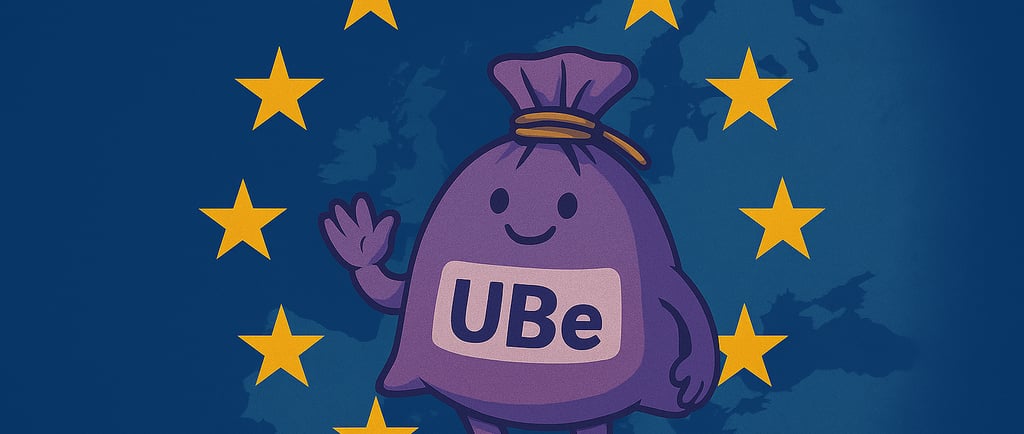Why Ube Powder Could Be Europe’s Next Big Food Trend
Ube powder is versatile, stunning on the plate, and packed with flavour — making it ideal for health food brands, cafés, dessert makers, and innovation-led distributors. More importantly, European markets haven’t caught up yet.


Europe is always a few steps behind the U.S. and Asia when it comes to food trends — but that lag is where the opportunity lies.
Right now, ube — a vibrant purple yam with a sweet, nutty taste — is exploding in popularity across Asia and beginning to catch fire in North America. If you're in Europe and you’re in the food business, this is your moment to move first.
Ube powder is versatile, stunning on the plate, and packed with flavour — making it ideal for health food brands, cafés, dessert makers, and innovation-led distributors. More importantly, European markets haven’t caught up yet.
In this article, you'll see why Europe is perfectly positioned to embrace ube, how it's following the same successful trajectory as matcha, and why importing from Indonesia gives you a cost, scale, and logistics advantage from day one.
What Makes Ube a Natural Fit for European Consumers
Let’s start with what makes ube so appealing.
Ube (pronounced oo-beh) is a purple yam originally from the Philippines, known for its natural vibrant colour and subtle, sweet flavour — often compared to vanilla, coconut, or white chocolate. It’s already a staple in Filipino desserts like ice cream, cakes, and pastries.
So why does this matter for Europe?
Because European consumers are becoming more visual, more adventurous, and more wellness-focused — and ube ticks all three boxes:
Visual: Its natural purple colour pops on social media and packaging.
Flavour: It’s sweet but subtle, making it easy to adapt into baked goods, smoothies, drinks, and desserts.
Novelty: Ube offers something new, yet it’s grounded in tradition — which helps with consumer trust.
If you’re targeting Gen Z, plant-based eaters, or the premium dessert market — ube fits right in.
The Global Trend is Moving West — And Europe is Next
Ube is following the same global trend arc we’ve seen with other now-mainstream ingredients.
Asia (origin and early adoption) – Ube has long been used in Filipino desserts and has already spread to trendsetting cities in Japan and Korea.
North America (trend explosion) – Ube is now appearing in Trader Joe’s, Whole Foods, Instagram cafés, and viral TikToks.
Europe (next frontier) – Most European consumers still haven’t tasted it.
If you import, distribute, or create food products in Europe, this is exactly where you want to catch a trend — right before it hits the mainstream. You’ll have the space to build brand associations, secure exclusivity, and lead the market instead of reacting to it.
Matcha Walked So Ube Could Run
If you remember the early days of matcha in Europe, it felt niche — too green, too unfamiliar, too hard to sell. Now? You’ll find matcha in lattes, ice creams, skincare, health supplements, and cereal bars. The brands that moved early are now dominant.
Ube is at the same point matcha was 7–8 years ago.
But with one key difference: ube is sweeter and more dessert-friendly right out of the gate. It doesn’t require consumer education or flavour adjustment. In fact, once people taste it, they usually want more.
This is a golden window. You can apply the matcha playbook — with better odds of adoption and a whole lot less competition (for now).
Why Indonesia is the Best Country to Source From (Especially for European Importers)
When people think of ube, they often think of the Philippines. But if you're importing into Europe, Indonesia is a better strategic choice — here’s why:
✅ Lower Costs
Indonesia has around 19% lower tariffs than other Southeast Asian countries like Vietnam or Malaysia when exporting food ingredients. That’s margin you keep.
✅ Bigger Farming Potential
Indonesia has more land and a growing commercial farming infrastructure for ube. That means more reliable supply and the ability to scale with your demand.
✅ Better Manufacturing & Export Readiness
Indonesia is stronger than the Philippines when it comes to food processing, powder manufacturing, and logistics. You’ll get:
Better powder consistency
Faster fulfilment timelines
Lower freight and port issues
For a European buyer, that means fewer headaches and more control over quality and lead time.
Final Word: Bring Ube to Europe Before Someone Else Does
European food trends move slower — but that’s why you win when you move early.
Ube is already booming across Asia and North America. It’s only a matter of time before it becomes the next matcha or turmeric here in Europe. And the brands who move first? They’ll own the shelf space, the awareness, and the profits.
With Indonesia offering lower costs, better scalability, and smoother logistics, you don’t just have a trend — you have a competitive edge.
If you're a food distributor, importer, or brand developer in Europe:
Now is the time to get ahead of the curve. Start sourcing ube powder — and lead the trend.
www.ubejava.com
